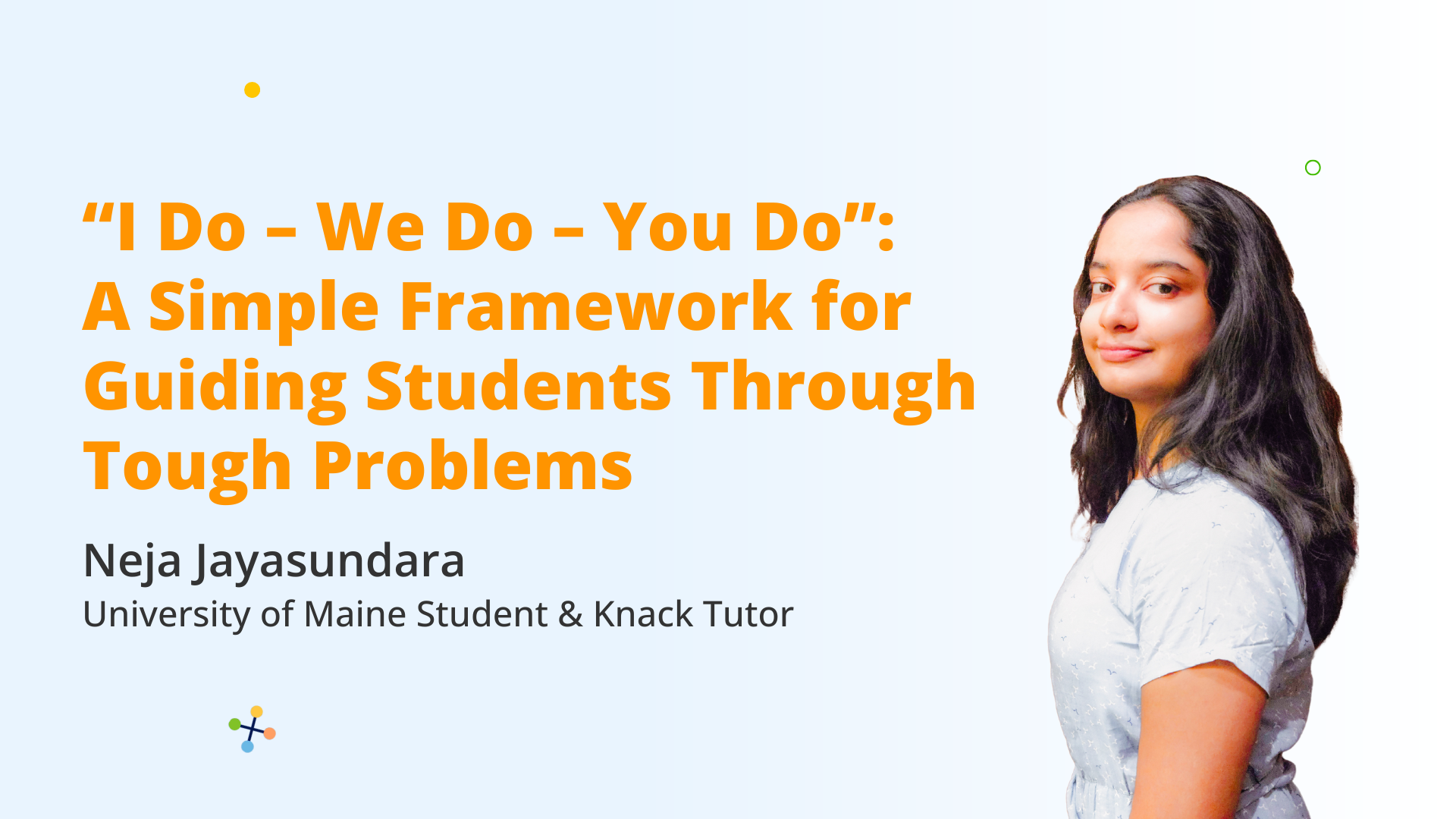Have you ever finished a tutoring session and realized you did most of the talking? It’s something every tutor experiences at some point. That moment when you realize your student is nodding along but not really doing the learning yet. It’s not that they aren’t trying; they just haven’t been given the space to take ownership of the process. That realization is what led me to the “I Do – We Do – You Do” framework, a simple but powerful way to guide students from dependence to independence. I first shared this approach during my KnackCon 2025 session, and it immediately resonated with so many peer tutors who had experienced the same challenge.
The “I Do – We Do – You Do” model is based on what educators call the gradual release of responsibility. In simple terms, it means that the tutor starts by taking the lead, then shares control with the student, and finally steps back so the student can take over. In the “I Do” stage, the tutor models the process, showing how to solve a problem or complete a task while thinking out loud. The key is to explain not only what you’re doing, but also why. This helps the student understand the reasoning behind each step, not just the sequence. The “We Do” stage comes next. This is where the tutor and student collaborate to solve a similar problem together. It’s the heart of the session—a shared space where the tutor provides guidance, but the student begins to take small risks and make their own choices. Finally, the “You Do” stage is where independence happens. The student applies what they’ve learned to solve a problem on their own, while the tutor observes and offers feedback. If the student struggles, the tutor can always circle back to “We Do” briefly before returning to independence.
I’ve found this approach especially effective in my science tutoring sessions. For example, one of my chemistry students once struggled with balancing redox equations. At first, they didn’t know where to begin, and I could tell they felt stuck. During the “I Do” stage, I solved one example myself, narrating each step out loud: identifying oxidation states, writing half-reactions, and checking for balanced electrons. Then, we moved into the “We Do” stage, where I gave them a similar equation and we worked through it together. I prompted them with questions like, “What do you think comes next?” or “Does this make sense so far?” This stage felt collaborative. They were learning by doing, not just watching. Finally, in the “You Do” stage, I gave them a new problem to try on their own. I stayed quiet but attentive, resisting the urge to jump in too soon. When they got stuck, I waited to see how they’d reason through it. After a few moments, they corrected themselves and successfully balanced the equation. That small victory meant more to them than any perfect explanation I could have given. They left the session not only understanding redox reactions better but also believing in their ability to work through challenges independently.
Of course, like any strategy, the “I Do – We Do – You Do” framework takes practice to use effectively. I’ve caught myself making some common mistakes, especially early on. Sometimes I stayed in “I Do” too long because I wanted to make sure they understood everything before trying. The problem is that students learn best when they’re actively involved, so spending too much time explaining can make them passive. I’ve also jumped too quickly to “You Do,” thinking a student was ready to work alone when they actually needed more guided practice. The fix in both cases is to read your student’s cues. If they can predict what comes next, it’s probably time to move forward; if they still look unsure, stay collaborative a little longer. Another easy mistake is forgetting to pause. Silence can feel awkward, especially online, but giving students a few seconds to think before answering is often when the real learning happens.
One of the best things about this framework is that it also works beautifully in group settings. In a group, I’ll model one example for everyone (“I Do”), then we’ll solve the next one together as a class or in small pairs (“We Do”), and finally, each student will work individually (“You Do”). This structure keeps everyone engaged and ensures that no one feels left behind. Even in groups, the same principle applies: show, guide, and step back.
What makes the “I Do – We Do – You Do” approach so effective is that it mirrors how learning naturally happens. At first, students need to see what success looks like; then they need guided practice with feedback; and finally, they need space to apply what they’ve learned. Peer tutors are in a unique position to support this process because we’re close to our students’ experiences. We know how it feels to struggle, and we know how rewarding it is to figure things out on our own. This framework helps us strike that balance between being supportive and fostering independence.
The next time you’re tutoring, try asking yourself: Where am I right now—I Do, We Do, or You Do? That simple self-check can completely change the tone of your session. If you notice yourself talking more than the student, shift toward “We Do.” If they’re confident, step back into “You Do.” The goal isn’t perfection. It’s progress. Tutoring isn’t about having all the answers; it’s about helping students discover how capable they already are. And that’s what the “I Do – We Do – You Do” framework is really about: guiding students through tough problems while building their confidence, independence, and belief in their own learning.
